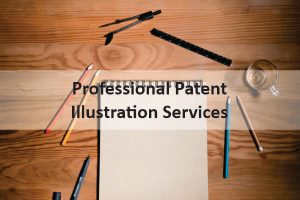Patent Illustrations refer to the representation of complex inventions or ideas on paper for a better understanding of them. Accordingly, patent illustration requirements are set by the U.S Patent and Trademark Office (USPTO) for these representations. Patent illustrations include drawings, photographs, flowcharts, bar graphs, etc.

Figure 1: Patent Illustration of a Quadcopter Drone
Must Read: Patent Illustrations: The Key to A Patent
What all are the patent illustration requirements as per the USPTO?
Following are the basic ‘Patent Illustration Wants’ as per the USPTO which you should follow when you are making Patent Drawings:
- Black ink on white paper. Additionally, the white paper must be matte, flexible and strong with only one side of the paper having written text.
- The size of the paper should be either 21cm*29.7cm or 21.6cm*27.9cm.The margins on the paper should also be of specific lengths i.e., 2.5 cm on the top, 2.5 cm on the left side, 1.5 cm on the right side, and 1.0 cm on the bottom.
- Only design patents and utility patents may include coloer drawings and that also on rare cases.
Also, you must file a petition if colored drawings are necessary with respect to the invention or for its better understanding. Pay specified fees and seek permission to use them.
- The Patent Illustration Requirements of the USPTO ask you to contain as many views as necessary to properly explain and display the invention.
Some of the views can be:
- The standard six views: front, back, top, bottom, right and left.
- Perspective views with 3-dimensions.
- Sectional views to show the various functions involved.
- Exploded views show the working and functionality of any single part of the invention.
- Drawings should be in upright form.
- You may use High-definition photographs in cases where they are the only practical method of displaying and explaining the invention.
- As per the USPTO’s Patent Illustration Demands, you must draw the drawing (or illustration) on such a scale that it avoids crowding when reduced to 2/3rds of its size.
- Shading helps in understanding the invention better. However, you must avoid solid black shading, except in cases of bar graphs or colour representation.
- Use numbers instead of letters as reference characters in the drawing.
Some additional instructions
The USPTO also advises you to follow some additional instructions to get the accurate and illustrative patent drawing. They are:
- You should always include identification above each drawing, the invention name, name of inventor, and application number.
- Avoid over-writings, alterations, erasures, and interlineations.
- Never superimpose one drawing over another,
- The USPTO’S patent illustration requirements, lets you use symbols and legends wherever necessary.
- Avoid making holes in the paper.
- You should number each page and view in Arabic numerals.
- Try to make the drawings as arresting and impressive as possible after following all the necessary conditions.
You can read the detailed requirements by USPTO for patent illustrations, here.
Why should you follow these rules?
These certain patent illustration rules, set by the USPTO, should be strictly adhered to. It is so because patent drawings (or illustrations) describe and demonstrate the invention with great accuracy and simplicity.
They also increase the chance of your patent application getting accepted. And hence, for the same reason, it is mandatory to attach at least one patent drawing with your non-provisional patent application.

Figure 2 shows an old patent illustration of a Golf Tee and Figure 3 shows an old patent illustration of a Golf Bag
Must Read: Patent Illustration Importance from Multiple Perspectives
Hire a Draftsman or Do It Yourself?
Hiring a draftsperson or doing it on your own, both have their own boons and banes.
By vigilantly following the Patent Illustration Needs, you can definitely make drawings of your invention all by yourself. The drawings can be made using pen-and-paper or using patent drawing software like Computer-Aided Design (CAD). One of the major benefits of making drawings on your own is that you are well aware of even the minutest detail of your invention.
It also saves you from spending money on hiring a professional.
However, if you lack skill, have no patience, and do not want additional pressure on your mind, then a professional draftsperson can prove to be an asset.
Where to Find the Best and Cost-friendly Draftsman?
Your search for the best Draftsperson for your patent illustration ends here @ Patent Illustration Express. PIE is a U.S.-based company, serving clients from all across the globe (45+ countries) over the years. The Patent Illustration Express has found its feet in the industry and offers services like “Utility Patent Illustration” and “Design Patent Illustration” with easy ordering and super fast delivery. It complies 100% with the rules and does free iterations in the output until customer satisfaction.
Go through our samples or service pricing and show your confidence in us without any worry!
Visit our website ( Patent Illustration Express) or contact us here.



